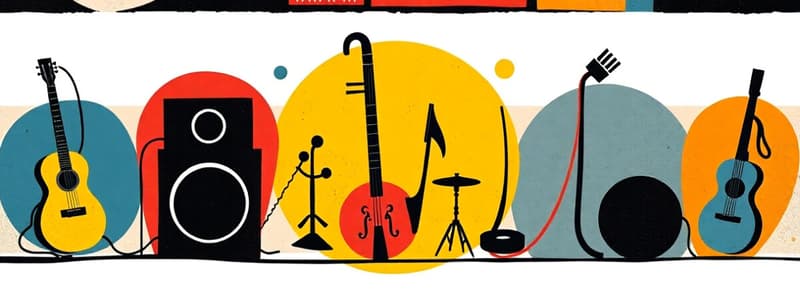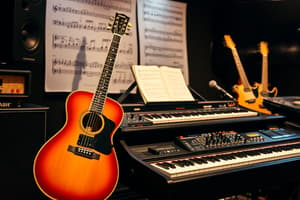Podcast
Questions and Answers
What distinguishes string instruments from other types of musical instruments?
What distinguishes string instruments from other types of musical instruments?
- They produce sound through a vibrating string. (correct)
- They are always played with a bow.
- They are made primarily from wood.
- They require air flow to generate sound.
Which instrument is classified as a bowed string instrument?
Which instrument is classified as a bowed string instrument?
- Violin (correct)
- Guitar
- Piano
- Harp
How does a piano produce sound?
How does a piano produce sound?
- By vibrating air through a pipe.
- By plucking strings with fingers.
- By using electronic sound waves.
- By striking steel strings with felt hammers. (correct)
What is a key characteristic of a double bass?
What is a key characteristic of a double bass?
Which of the following statements about violins is accurate?
Which of the following statements about violins is accurate?
What differentiates the viola from the violin?
What differentiates the viola from the violin?
Which type of instrument typically uses a bow for sound production?
Which type of instrument typically uses a bow for sound production?
What is a common feature of brass instruments?
What is a common feature of brass instruments?
What is the primary method of playing a harp?
What is the primary method of playing a harp?
Which percussion instrument is characterized by being made from a small round steel tube?
Which percussion instrument is characterized by being made from a small round steel tube?
What is the defining characteristic of chimes compared to other percussion instruments?
What is the defining characteristic of chimes compared to other percussion instruments?
Which statement about the xylophone is correct?
Which statement about the xylophone is correct?
What type of sound does a tambourine produce when its jingles are activated?
What type of sound does a tambourine produce when its jingles are activated?
How is a bass drum typically played?
How is a bass drum typically played?
Which of the following instruments is considered part of the woodwind family?
Which of the following instruments is considered part of the woodwind family?
What distinguishes cymbals from other percussion instruments?
What distinguishes cymbals from other percussion instruments?
What feature distinguishes the piccolo from the flute?
What feature distinguishes the piccolo from the flute?
How does a player produce sound on a saxophone?
How does a player produce sound on a saxophone?
Which of the following materials is most commonly used to make a piccolo?
Which of the following materials is most commonly used to make a piccolo?
What is the primary function of the valves on a tuba?
What is the primary function of the valves on a tuba?
What mechanism does a trombone use to change pitches?
What mechanism does a trombone use to change pitches?
What is the main characteristic of brass instruments?
What is the main characteristic of brass instruments?
Which instrument is known as the lowest-sounding member of the brass family?
Which instrument is known as the lowest-sounding member of the brass family?
Which statement about the flute is accurate?
Which statement about the flute is accurate?
Flashcards are hidden until you start studying
Study Notes
Musical Instruments
- Musical Instruments are devices used to make music.
- Anything that produces sound can serve as a musical instrument.
- "Musical Instrument" is generally reserved for items with a specific musical purpose.
Types of Musical Instruments
- Musical instruments are categorized based on how they make sound.
- String Instruments: Produce sound from vibrating string.
- Percussion Instruments: Played by striking, shaking, or scraping.
- Woodwind Instruments: Played by blowing air into the mouthpiece.
- Brass Instruments: Produce sound by buzzing lips while blowing air through a mouthpiece.
String Instruments
- Strings are made of metal, synthetic, or natural materials.
- The strings can have different gauge or thickness, weight, length, and tension.
Piano
- A keyboard instrument that produces sound by striking steel strings with felt hammers.
- Vibrations are transmitted through a bridge to a soundboard that amplifies them.
Guitar
- A musical instrument with ancient roots used in various musical styles.
- Typically has six strings, although four, seven, eight, ten, and twelve-string guitars also exist.
- Usually held flat against the player's body and played by strumming or plucking the strings.
Violin
- A bowed string instrument with four strings tuned in perfect fifths.
- The smallest and highest-pitched member of the violin family of string instruments.
- Held between the left collar bone and chin.
- Has no frets or other makers on the fingerboard.
Other Members of the Violin Family
- Viola: Slightly larger and has thicker strings, producing a richer, warmer sound.
- Cello: Much larger and has thicker strings than the violin or viola. The cello's sound is similar to a human voice and can create a wide range of tones.
- Double Bass: The biggest member of the string family, with the longest strings.
Harp
- Has about 45 strings stretched across a tall triangular frame.
- Strings are plucked by hand, while seven pedals adjust the length of the strings to produce additional notes.
Percussion Instruments
- Played by striking, shaking, or scraping.
Triangle
- Made from a small round steel tube.
- Played by striking with a steel beater.
- Its bright shimmering sound is untuned and resembles that of a bell.
Chimes
- Also called 'Tubular Bells'.
- A tuned instrument consisting of a set of 12 to 18 metal tubes hung from a metal frame.
- Played by striking with a mallet (small hammer) and sound like church bells.
- The longer the length of the tube struck, the lower the pitch.
Xylophone
- A tuned instrument made of hardwood bars in graduated lengths set horizontally on a metal frame
- Played by striking the bars with hard mallets, producing a bright, sharp sound.
Tambourine
- A shallow, handheld drum made of a circular wooden frame.
- Has small discs called 'jingles' set into its circular frame.
- Produces sound when shaken, rubbed, or struck on the drumhead.
Bass Drum
- Much larger than a snare drum
- Played on its side so that either head may be struck.
Cymbals
- Made from two large, slightly concave brass plates.
- Fitted with leather hand straps.
- Crashed together, producing a wide range of sound effects.
Woodwind Instruments
- Played by blowing into the mouthpiece.
- Vibrations begin when air is blown across the top of an instrument, across a single reed, or across two reeds.
- Usually have finger holes or keys that produce tones.
- Characterized by a cylindrical or conical tube of wood or metal usually ending in a slightly flared bell
Flute
- About 2 feet in length.
- Looks like a narrow tube with a row of holes covered by keys along one side.
- The player blows air across the small hole in the mouthpiece to produce a sound.
Piccolo
- An instrument of orchestras and military bands.
- The piccolo is like the flute but smaller.
- The pitch of the piccolo is higher than that of a flute.
Oboe
- Made from wood and has metal keys.
- It has two reeds tied together.
Saxophone
- Conically shaped, the Saxophone is the only woodwind instrument made of brass.
- A single-reed woodwind instrument.
- The pitch is controlled by opening and closing holes in the body.
Brass Instruments
- Usually characterized by a long cylindrical or conical metal tube commonly curved two or more times ending in a flared bell shape.
- Produce their unique sound by the player buzzing his/her lips while blowing air through a cup- or funnel-shaped mouthpiece.
- The mouthpiece connects to a length of brass tubing ending in a bell
Tuba
- The lowest-sounding member of the brass family.
- Has four to five valves and is held upright in the player's lap.
Trombone
- Larger than a trumpet, producing a more mellow sound.
- Instead of valves, the trombone has a slide that changes the length of its tubing to reach different pitches.
Trumpet
- The highest-sounding member of the brass family.
- The player presses the three valves in various combinations with the fingers of the right hand to obtain various pitches.
Studying That Suits You
Use AI to generate personalized quizzes and flashcards to suit your learning preferences.




